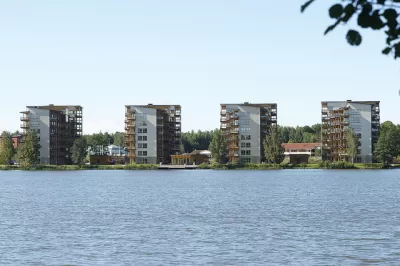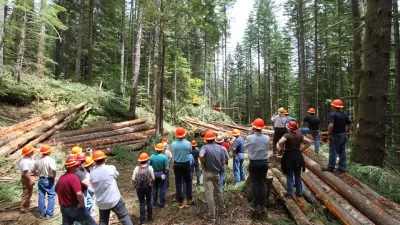Building with wood is back in fashion, but lumber producers have to reckon with thorny politics and new timber-based materials that have yet to be truly defined.

Matthew Messner reviews the history and politics of wood as a building material in a special timber issue of The Architect's Newspaper:
“Over the past 150 years, the process and politics of wood have shaped a highly efficient industry that still provides the vast majority of the U.S.’s house-building material. With new technology, wood is pushing into new territories, and the lumber industry is bracing to respond to these demands.”
Anyone following developments in the built environment has seen the re-rise of wood construction. Timber towers are going up in France, in England, and most recently, “an academic and professional collaboration” produced a timber-based design for the River Beech Tower in Chicago, in part because “it is lighter, more easily transportable and has a smaller environmental impact than its concrete or steel counterparts.”
“Although the lumber industry is confident it can handle an increase in demand,” Messner writes, “there are factors that will need to be addressed.” These include political maneuvering between the U.S. and Canada, updating fire codes, and establish legal definitions for new products like cross-laminated timber (“a true wonder material,” maybe).
FULL STORY: The lumber industry looks to respond to the rise of mass timber

Maui's Vacation Rental Debate Turns Ugly
Verbal attacks, misinformation campaigns and fistfights plague a high-stakes debate to convert thousands of vacation rentals into long-term housing.

Planetizen Federal Action Tracker
A weekly monitor of how Trump’s orders and actions are impacting planners and planning in America.

In Urban Planning, AI Prompting Could be the New Design Thinking
Creativity has long been key to great urban design. What if we see AI as our new creative partner?

King County Supportive Housing Program Offers Hope for Unhoused Residents
The county is taking a ‘Housing First’ approach that prioritizes getting people into housing, then offering wraparound supportive services.

Researchers Use AI to Get Clearer Picture of US Housing
Analysts are using artificial intelligence to supercharge their research by allowing them to comb through data faster. Though these AI tools can be error prone, they save time and housing researchers are optimistic about the future.

Making Shared Micromobility More Inclusive
Cities and shared mobility system operators can do more to include people with disabilities in planning and operations, per a new report.
Urban Design for Planners 1: Software Tools
This six-course series explores essential urban design concepts using open source software and equips planners with the tools they need to participate fully in the urban design process.
Planning for Universal Design
Learn the tools for implementing Universal Design in planning regulations.
planning NEXT
Appalachian Highlands Housing Partners
Mpact (founded as Rail~Volution)
City of Camden Redevelopment Agency
City of Astoria
City of Portland
City of Laramie





























